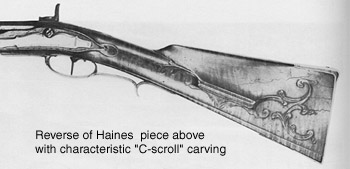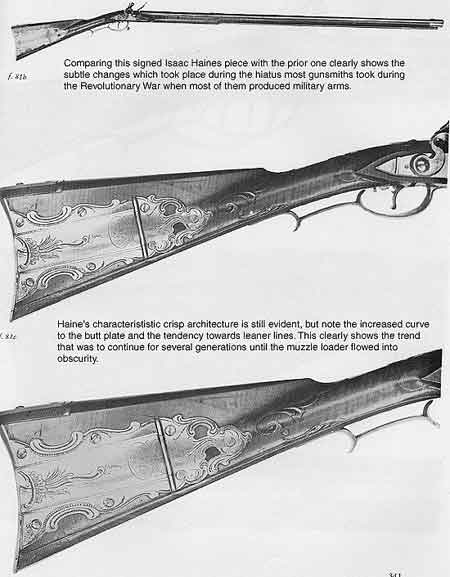Page Three
 Lancaster County
was one of the first areas settled and was incorporated in 1729.
It was to become one of the pronounced centers for arms manufacturing
and its craftsmen became well known for their style and execution.
Several generalities about rifles from this area during the "golden
age" (1770-1840) can be made: The butt stocks tend to be
straighter, with fewer curved top lines than the rest of the
schools and their brass patch boxes, usually engraved, often
worked daisies into their motif. This is the school we've chosen
to replicate in the accompanying construction article.
Lancaster County
was one of the first areas settled and was incorporated in 1729.
It was to become one of the pronounced centers for arms manufacturing
and its craftsmen became well known for their style and execution.
Several generalities about rifles from this area during the "golden
age" (1770-1840) can be made: The butt stocks tend to be
straighter, with fewer curved top lines than the rest of the
schools and their brass patch boxes, usually engraved, often
worked daisies into their motif. This is the school we've chosen
to replicate in the accompanying construction article.
The wood of choice was tightly striped "tiger stripe" or "fiddle back" maple. Maple was plentiful in the Pennsylvania hills although only 5% of the red maple trees had curl and less than .5% of the denser sugar maples had it. However, once a good sized tree with curl was felled, it would yield enough stock blanks to keep a number of gunsmiths busy for some time.
It is likely that for every rifle using fancy wood, there were dozens made using a more common grades of wood. The survival rate, however, greatly favors the higher quality rifles because they existed in more up-scale social environments and their quality was recognized and protected throughout their lives. The more mundane rifles rarely survived to modern times because they were kept working until they were used up.
Maple is tough and light, but the colorful curly grain made it extremely difficult to work because each curl represents a partial reversal of the grain. Patience, wasn't a virtue, it was a necessity. The wood, nearly white in its natural state, was stained with a variety of compounds which darkened the softer grain more quickly causing the stripes to stand out. It was then usually rubbed down with many coats of boiled linseed oil.

In almost all cases, by 1840, styling had begun to get extreme, with random brass and silver inlays, less graceful lines, and no raised, rococo carving. In addition a huge trade had developed in plain, utilitarian pieces destined for the frontier, which had long since moved passed them by.
As man pushed west, the character of the rifle changed with the environment. The horse became the preferred method of travel and a slim wristed, long barrel weapon, exquisite though it may appear, was too cumbersome and entirely too fragile for the rigors of the new life. Also, the further west they went, the increased size of the game demanded a harder hitting firearm.
 By the time Ohio
was being settled the fragile full stock of the long rifle had
begun to give way to a half-stock design with a rib or number
of hoops under the barrel to retain the ramrod. Also, the barrels
rapidly shrank in length until 36" became a standard, but
they were much bigger in diameter and the caliber seldom went
above .45. Less attention was paid to decoration and more to
function.
By the time Ohio
was being settled the fragile full stock of the long rifle had
begun to give way to a half-stock design with a rib or number
of hoops under the barrel to retain the ramrod. Also, the barrels
rapidly shrank in length until 36" became a standard, but
they were much bigger in diameter and the caliber seldom went
above .45. Less attention was paid to decoration and more to
function.
The gold rush dragged hundreds of thousands of would-be miners and settlers out into the Great Plains and western mountains where the target was likely to be buffalo, mule deer, bear, Native Americans, or other gold seekers. The size of the balls fired again began to climb with the famed St. Louis Hawken rifles averaging .50-.54 caliber. The Hawken brothers, by the way, descended from a long line of gunsmiths who were there at the very beginning of the settlement of Lancaster, PA.
There is a widespread, and very mistaken, assumption that the
muzzle-loading rifle disappeared almost as soon as cartridge
arms appeared shortly after the civil war. This couldn't be further
from the truth. The average farmer and small rancher couldn't
afford one of the fancy new Winchesters or Sharps. Besides, with
the exception of being faster firing, the truth is that there
wasn't a thing these new fangled arms could do that a well tuned
flint or cap lock muzzle loader couldn't do as well or better.
Besides, powder and ball was both cheaper and easier to carry
than cartridges. Many gunsmiths and small factories were still
building muzzleloaders well into the 1880's and many international
target teams didn't give up their muzzleloaders until long after
that time. Some of the best examples of surviving long rifles
exist today because, as late as the 1930's in areas of the rural
south, "granddaddy's" rifle was brought down from the
attic every hunting season to gather that year's quota of venison.
The muzzle-loading rifle, which many feel reached its zenith
in the long rifles of the 1770-1800 period, is an artifact from
a time and culture that we shouldn't forget. We were a proud
nation then and we are a proud nation now. The "a gun is
a gun and they are all for killing" mind-set which is permeating
much of the press as well as a new generation, ignores, or can't
appreciate, the art of the gun or its place in history. It is
my hope that through some of the articles we're going to present
on the subject of firearms, that a segment of the population
which seldom thinks about firearms will reflect on the true legacy
which they have left us.
All of the photographs are from the works of George Shumway and Doctor James Whisker with the Hawken from John Baird's "Hawken Rifles, the Mountain Man's Choice," (The Gun Room Press).
Shumway and Whisker have devoted much of their lives to illustrating and documenting the long rifle in it's many guises and both have published and/or written a number of excellent books on the subject. Their books should be part of every historian or firearms enthusiast's library.
| George Shumway Publishing 3900 Deep Run Lane York, PA 17402 (717) 755-1196 |
James Whisker Old Bedford Village Press Box 1976 Bedford, PA 15522 (814) 623-1156 |
| To enter the sub-culture of the
muzzle loading and long rifle enthusiast, join the National
Muzzle Loading Association and receive Muzzle Blasts,
their fun and informative magazine. Tell them Airbum.com sent you. :-) NMLRA Box 67 Friendship, IN 47021 (812) 667-5131 |
|
To enter the sub-culture of the muzzle loading and long rifle enthusiast,
join the National Muzzle Loading Association and
receive Muzzle Blasts, their fun and informative magazine.
Tell them Airbum.com sent you. :-)
NMLRA
Box 67
Friendship, IN 47021
(812) 667-5131